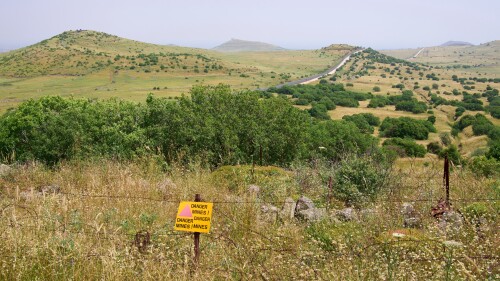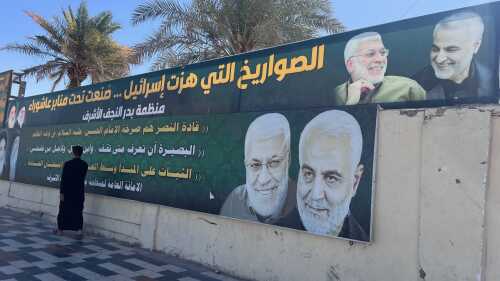Social media graphic for Quwat al-Ghadab (no official insignia/emblems in existence). |
Christians in the east of Syria, where Syriac liturgy denominations constitute the majority of Christians, are primarily known to have joined militias of Syriac orientation, such as the pro-regime Sootoro/Gozarto Protection Forces based in Qamishli and the pro-PYD administration Sutoro affiliated with the Syriac Union Party.
Closely linked to the Sutoro is the Syriac Military Council, which is affiliated with the Mesopotamia National Council. In the west of Syria, the main militia known to have attracted Christian support is the Nusur al-Zawba’a (Eagles of the Whirlwind) of the Syrian Social Nationalist Party (SSNP), which is aligned with the regime and has engaged on a variety of fronts throughout western Syria, including a recent attempted regime push into Raqqa province alongside other militias like Suqur al-Sahara’ and Fawj Maghawir al-Bahr.
A more local formation of interest in the west of Syria is Quwat al-Ghadab (“The Forces of Rage”), which is based in the Christian (specifically Greek Orthodox) town of Suqaylabiyah in northwestern Hama province.
Suqaylabiyah is known as a base of support for the regime and hosts multiple political and military actors on the regime side, including a local branch of the National Defence Forces (NDF) and a local branch of the SSNP.***
A post suggesting Quwat al-Ghadab is linked to Syrian air force intelligence. |
According to one representative for Quwat al-Ghadab, the militia’s founding dates to 16 March 2013 in order to defend Suqaylabiyah and its countryside, and it is affiliated with the Republican Guard and the general command for Syria’s army and armed forces.
Some posts also point to links with Syrian air intelligence, such as the notification at right on the New Year for 2016 featuring a Syrian air intelligence logo:
We ask our people in the town of Suqaylabiyah not to celebrate the advent of 2016 with gunfire and take the foremost measures of caution and safeguarding. And this is not out of fear of terrorism on their part but rather to preserve your safety. And the men of al-Ghadab, of the sleepless eye, are in utmost readiness and at points of confrontation in their correct places, ready to respond and resist in order to protect the beloved Suqlab, the town of steadfastness. We will not let them pass except as lifeless corpses.
From the open source data, the engagements seem to be primarily confined to areas in relative proximity to Suqaylabiyah. For example, Quwat al-Ghadab was involved in the defence of Tel Othman against rebel forces, which captured Tel Othman in early November 2015.
Left: Invitation to a commemoration of Hadi al-Adlah, 11 December 2015. The imagery is common for Christian “martyrs.” Right: Note the tattoo of the cross on his arm. |
During the Tel Othman campaign, Quwat al-Ghadab lost at least one fighter in a person called Hadi Adnan al-Adli (also known as Hadi al-Adlah).
Posts on Hadi’s personal Facebook account suggest he was a devoted Christian.
For example, in a post on 22 September 2015, he called on Jesus to have mercy on him, describing himself as his “servant in error [/sin].”
More recently, Quwat al-Ghadab has been operating in the mountains of Latakia.
The leader of Quwat al-Ghadab is a man called Philip Suleiman, who appears to be particularly close to theleader of the Suqaylabiyah NDF branch Nabil (al-)Abdullah.
Philip Suleiman in his base. Note the plaque on the table:"Quwat al-Asdiqa': Regiment 45. Base leader: Philip Suleiman.” |
A Syrian military document from October 2014 gives a more precise outline of Philip Suleiman’s role in Hama, pointing to his militia’s function as a reserve force for the Syrian army in part to deal with issues of draft dodging, which became more apparent after the regime’s losses in 2015 to rebels in Idlib and the refugee crisis:
Mr. Philip Farid Suleiman from the town of Suqaylabiyah national ID number 05100010726 born in 1968 is entrusted with an official assignment by Quwat al-Asdiqa’ and that is to draw in and recruit civilian personnel and those wanted for compulsory and reserve service in the province of Hama for the interest of Quwat al-Asdiqa’. The security authorities are asked to provide the necessary aid and facilitation, thanking you for your cooperation.
Philip Suleiman came to greater attention in late March of this year when he was briefly detained by the regime.
An angry social media post following Suleiman’s arrest. |
According to the Quwat al-Ghadab representative this author spoke with, he was arrested on accusations of smuggling diesel and petrol. His arrest sparked widespread outrage on the local social media and protests in the town. The post at right reads:
The car of the lion Abu Uday Philip Suleiman and traces of his blood on it. The beasts of the regime’s security apparatus arrested him after opening fire on his car!!!! He has not hoarded anything, stolen from anyone, paid or taken bribes from anyone, or betrayed his homeland and town. So the corrupt people hated him. He will come out with his head high and in defiance, while every dog who has written a false report against him will taste and drink his death. On your reckoning, but the hero will return.
One of the placards reads: “We are not terrorists. We are the Syrian Arab Army: Majmu’at al-Ghadab [the Rage Groups – another name for Quwat al-Ghadab].” |
Philip Suleiman was eventually released, and returned to Suqaylabiyah in a procession with greetings. No further incident has since come to light.
Despite this brief flare-up of internal tensions, the town is unlikely to shift towards any sentiments of sympathy for the insurgency anytime soon, particularly as it has been subject to rebel bombardment on multiple occasions, leading to the death of civilians.
Moreover, from Kasab in Latakia to Qamishli in Hasakah, the record of the rebel groups and the Islamic State towards the Christian minorities is hardly reassuring.
Appendix note on the SSNP
The SSNP is known to exist in two distinct branches, the Syrian under Joseph Sweid and the Lebanese under As’ad Hardan. In terms of the Nusur al-Zawba’a output that is observed on social media, it can largely be traced to the efforts of Hardan’s branch, which is indeed the main force organizing the Nusur al-Zawba’a militia effort in Syria. Thus, the best known Facebook page for Nusur al-Zawba’a-SSNPMediawars– and the associated Telegram channel show an affiliation with Hardan. For example, see the post below left from 8 June 2016 on SSNPMediawars.
“The ‘political direction’ in the forces of ‘Nusur al-Zawba’a’ displays sections from a direction speech by the head of the party, secretary [general] As’ad Hardan inside one of the ‘Nusur’ camps.” |
Similarly, a page for the “Suqaylabiyah directorate” of the SSNP points to an affiliation with Hardan. Besides the military contribution in the form of the Nusur al-Zawba’a militia, there is also outreach to the local population, including the youth of Suqaylabiyah. It is therefore apparent that Hardan’s SSNP has used the Syrian civil war to project influence into regime-held Syria, reflecting a wider trend among the militia actors on the regime side. Indeed, 30 candidates were fielded for the Syrian parliamentary elections in April.
In contrast, the Syrian SSNP maintains its own Facebook page – wssnpsy. There is evidence for tensions between the Syrian and Lebanese SSNP branches inside Syria, as members of Nusur al-Zawba’a affiliated with the Lebanese SSNP attacked an office of the Syrian SSNP in Damascus, prompting a condemnation from the Syrian SSNP issued on 14 June 2016. While the Syrian SSNP urged for its members not to be drawn into internal strife, it asked the Lebanese SSNP to condemn the assault, warning that failure to do so would lead to repeated incidents of this type and amount to approval/orders from the Lebanese SSNP.
Aymenn Jawad Al-Tamimi is a research fellow at Middle East Forum’s Jihad Intel project.













